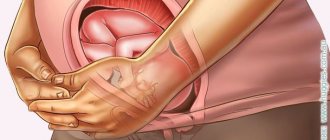The concept of “narrow pelvis”
During the pushing period, when the fetus is expelled from the uterus, it must overcome the bony ring of the birth canal, that is, the small pelvis. The pelvis consists of 4 bones: 2 pelvic bones, formed by the ilium, pubis and ischium, the sacrum and the coccyx. These bones contact each other with the help of cartilage and ligaments. In women, the pelvis, unlike in men, is wider and more voluminous, but has less depth. Normal pelvic parameters play an important role in the physiological, without complications, course of childbirth. If there are deviations in the configuration and symmetry of the pelvis and a decrease in size, the bony pelvis acts as an obstacle to overcoming the fetal head.
In practical terms, a narrow pelvis is divided into 2 types:
- anatomically narrow pelvis, which is characterized by a decrease in one/several dimensions by 2 cm or more;
- a clinically narrow pelvis develops when there is a discrepancy between the size of the child’s head and the anatomical size of the woman’s pelvis during childbirth (but even in the case of anatomical narrowing of the pelvis during childbirth, the occurrence of a functionally narrow pelvis is not always possible, for example, if the fetus is small in size, and vice versa, with normal anatomical indicators pelvis and a large baby, the occurrence of a clinically narrow pelvis is quite likely).
Pelvic dimensions: norm and deviations
Every woman knows very well what a pelvis is. It is conventionally divided into large and small. It is in the large pelvis, towards the end of pregnancy, that the uterus and fetus are accommodated. And if for some reason its wings are not straightened, then the uterus will move forward, as a result the tummy will “stick out” (become pointed). The small pelvis is a kind of birth canal through which the baby will move at birth. It is clear that if the pelvis turns out to be narrow, then the child will have a hard time “making his way” into the light.
How is the pelvis measured? Surely, if this has already been done to you, then you noticed an incomprehensible set of numbers on your card. If they look like this: 26-29-31-21, then there is nothing to worry about: your pelvis is normal. If any of the indicators is 2 numbers less, then you will be diagnosed with a narrow pelvis. What do these numbers represent? Regular sizes. For example, the interosseous size (the distance between the upper corners of the protruding bones) should be from 25 to 26 cm and so on. All measurements are carried out using a tazometer and a centimeter tape. By measuring the large pelvis from the outside, you can guess what the small pelvis will be like. The size of the latter can be determined by vaginal examination, and you may also be prescribed radiography and ultrasound to determine the size of the pelvis. Also, other factors indicate the narrowness of the small pelvis: hand length is less than 16 cm, shoe size is less than 36, height is less than 160 cm. When measuring the pelvis, it is imperative to take into account the massiveness of the pelvic bones, using the Solovyov index, i.e. measure the circumference of your wrist and if the size becomes more than 14 cm, then your bones are massive, which means your pelvis will be narrow even with normal values.
However, in reality everything is not so simple. A narrow pelvis has its own varieties and characteristics. Both the course of pregnancy and delivery depend on this.
Causes
The reasons for the formation of a narrow pelvis differ in its anatomical narrowing or the occurrence of a disproportion between the size of the baby’s head and the pelvic size of the mother.
Etiology of anatomically narrowed pelvis
The following factors can provoke the formation of an anatomically narrowed pelvis:
- disruptions in menstrual function, impaired reproductive function, late onset of menstruation;
- neuroendocrine pathology;
- frequent colds and excessive physical activity in adolescence;
- insufficient nutrition, heavy physical work in childhood.
Anatomical narrowing of the pelvis is caused by the following reasons:
- infantilism, both general and sexual;
- delayed sexual development;
- rickets;
- osteomalacia, bone tuberculosis and bone tumors;
- pelvic bone fractures;
- curvature of the spine (lordosis and kyphosis, scoliosis and coccyx fractures);
- cerebral palsy;
- constitutional features and heredity;
- polio;
- exostoses and pelvic tumors;
- damaging factors in the antenatal period;
- acceleration (rapid growth of the body in length and at the same time a slowdown in the increase in transverse pelvic dimensions);
- stressful situations and psycho-emotional stress, which contribute to the emergence of “compensatory hyperfunction of the body”, which forms a transversely narrowed pelvis;
- professional sports (gymnastics, skiing, swimming);
- impaired mineral metabolism;
- hypo- and hyperestrogenism, excess androgens;
- dislocations of the hip joints.
Etiology of a functionally narrow pelvis
Disproportion in labor between the baby's head and the mother's pelvis is caused by:
- anatomical narrowing of the pelvis;
- large size and weight of the fruit;
- difficulties in the configuration of the fetal cranial bones (true post-maturity);
- incorrect position of the unborn baby;
- pathological insertion of the head (asynclitism, frontal insertion, etc.);
- neoplasms of the uterus and ovaries;
- narrowing (atresia) of the vagina;
- presentation with the pelvic end (rare).
Childbirth complicated by a clinically narrow pelvis ends in 9–50% by caesarean section.
Narrow pelvis during pregnancy: sizes, 1,2,3,4 degrees
A narrow pelvis is considered one of the most complex and difficult sections of obstetrics, since this pathology can lead to the development of dangerous complications during childbirth, especially if they are performed incorrectly.
According to statistics, anatomical narrowing of the pelvic bones occurs in 1-7.7% of cases, while during childbirth such a pelvis becomes clinically narrow in 30%.
If we take the total number of all births, then this pathology accounts for about 1.7% of cases.
The concept of “narrow pelvis”
During the period when the fetus is expelled from the uterus or during the pushing period, the child must overcome the bone ring that is formed by the pelvic bones. This ring consists of 4 bones: the coccyx, the sacrum and two pelvic bones, which are formed by the ischium, pubis and ilium. These bones are connected to each other using ligaments and cartilage.
The female pelvis, unlike the male one, is larger and wider, but has less depth. A pelvis with normal parameters plays an important role in the normal, physiological course of childbirth without complications. If there are deviations in the symmetry and configuration of the pelvis, its size decreases, then the bony pelvis serves as a kind of obstacle to the passage of the fetal head.
In practical terms, two types of narrow pelvis are classified:
- a clinically narrow pelvis occurs in the event of a discrepancy between the anatomical dimensions of the woman’s pelvis and the dimensions of the child’s head during childbirth (however, even in the presence of an anatomical narrowing of the pelvis during childbirth, a functionally narrow pelvis may not always occur, for example, when the fetus is small in size, or vice versa, when functional pelvic indicators are normal, but the large size of the baby leads to the development of a clinically narrow pelvis);
- An anatomically narrow pelvis is characterized by a narrowing of several or one size by 2 or more centimeters.
Causes
The causes of a narrow pelvis are different - in the event of a disproportion between the parameters of the mother’s pelvic bones and the baby’s head or in the presence of an anatomical narrowing.
The following factors can provoke the occurrence of an anatomically narrowed pelvis:
- heavy physical work and poor nutrition in childhood;
- frequent colds, as well as increased physical activity in adolescence;
- neuroendocrine pathologies;
- late onset of menstruation, impaired fertility, disruptions in menstrual function.
Anatomical narrowing of the pelvis occurs due to the following reasons:
- dislocations of the hip joints;
- excess androgens, hyper- and hypoestrogenism;
- impaired mineral metabolism;
- practicing professional sports (swimming, gymnastics, licking);
- psycho-emotional stress and stressful situations that provoke the occurrence of “compensatory hyperfunction of the body”, as a result of which a transversely narrowed pelvis is formed;
- acceleration (rapid growth of the body in length against the background of a slow increase in transverse pelvic parameters);
- damaging factors that affected the fetus in the antenatal period;
- tumors and exostoses of the pelvis;
- polio;
- heredity and constitutional features;
- cerebral palsy;
- curvature of the spine (coccyx fractures, scoliosis, kyphosis, lordosis);
- pelvic bone fractures;
- bone tumors, bone tuberculosis, osteomalacia;
- rickets;
- delayed sexual development;
- infantilism, both sexual and general.
Disproportion between the mother's pelvis and the baby's head during childbirth is caused by:
- preposition with the pelvic end;
- atresia (narrowing) of the vagina;
- neoplasms of the ovaries and uterus;
- pathological insertion of the head (frontal insertions, asynclitism);
- malposition;
- difficulty in the process of configuration of the bones of the baby’s skull (in case of true postmaturity);
- large weight and size of the fetus;
- anatomical narrowing of the pelvis.
Childbirth, which is complicated by a clinically narrow pelvis, ends with a cesarean section in 9-50% of cases.
Gynecoid type
It makes up about 55% of the total number of pelvises and is a normal type of female pelvis. The future mother has a female body type, thin waist and neck, wide hips, height and weight are within the average range.
Android pelvis
It is a male-type pelvis and occurs in 20% of cases. The woman has a masculine physique, namely an undefined waist, a thick neck against the backdrop of narrow hips and broad shoulders.
Anthropoid pelvis
Platypeloid pelvis
Its shape resembles a flat pelvis and occurs in 3% of women. A woman with such a pelvis is tall, markedly thin, has reduced skin elasticity and underdeveloped muscles.
Narrowed pelvis: forms
Classification of a narrow pelvis according to Krassovsky.
Common forms:
- transversely narrowed pelvis (Robertovsky);
- generally uniformly narrowed pelvis (ORST) is the most common type, which is observed in 40-50% of the total number of pelvises;
- flat pelvis, occurs in 37% of cases, is divided into: a pelvis with a reduced wide part of the pelvic cavity;
- flat-rachitic;
- simple flat (Deventrovsky).
Rare forms:
- pelvic deformation by fractures, exostoses, bone tumors;
- obliquely contracted and obliquely displaced;
- other forms: assimilation;
- osteomalatic;
- spondylolisthetic form;
- kyphotic form;
- funnel-shaped;
- generally narrowed flat.
Degrees of narrowing
The classification proposed by Palmov is based on the degree of narrowing of the pelvis:
- according to the length of the true conjugate (normally 11 cm) it refers to a flat pelvis and ORST: first degree - less than 11 cm, not shorter than 9 cm;
- second degree - true conjugate indicators from 9 to 7.5 cm;
- third degree – the length of the true conjugate is from 7.5 to 6.5 cm;
- fourth degree – absolutely narrow pelvis, shorter than 6.5 cm.
- first degree - the transverse diameter of the entrance to the pelvis is within 12.4-11.5 cm;
- first degree – diameter is 12.4-11.5 cm;
Clinically narrow pelvis during pregnancy - this is exactly the diagnosis that treating specialists give to some expectant mothers. The presence of this pathology often causes various severe outcomes in women during childbirth. This is also one of the possible arguments for a planned caesarean section.
The growing uterus is located in the pelvic area. Due to its narrowness, the uterus does not expand, so the abdomen takes on a pointed shape. During childbirth, the baby moves through the open pelvis. A clinically narrow pelvis during childbirth can become a serious obstacle to the advancement of the fetus and the further outcome of delivery.
We suggest you read: Is it possible to give birth to a healthy child with toxoplasmosis?
There are some types of narrowing and features of gestation.
General definitions
Experts distinguish two types of narrowing: anatomically and clinically narrow pelvis. It is worth distinguishing between these concepts because they are different. The first term is detected when there is a deviation from the normal size of 2 cm. According to anatomical indicators, pelvic narrowing is classified as follows:
- Flat;
- Generally uniform narrowed;
- Narrowed in the transverse direction.
It is almost impossible to prevent such a pathology.
The main reasons for the development of anatomical pathology include the following points:
- Infectious diseases that the fair half suffered in the past.
- Hormonal imbalance during adolescence.
- Rickets, tuberculosis or polio, which have damaged bone tissue.
- Physical overexertion.
Clinically, a narrow pelvis during childbirth is detected at the moment when the doctor diagnoses discrepancies between the size of the baby’s head and the parameters of the woman’s pelvis. This occurs during the active phase of labor.
Sometimes mothers learn about this feature only after the baby is born. This pathology can become a companion for mothers who did not even know about such a problem during pregnancy.
There are the following degrees of pathology:
- Minor discrepancy;
- Significant;
- A complete mismatch.
The degree is determined taking into account the following important parameters, such as: nuances of head placement, absence or presence of movement, configuration feature.
Clinical type pelvic narrowing can develop for the following reasons:
- Large pregnancy, that is, more than 4 kg;
- Anatomically narrow pelvis;
- Transition during gestation, when the baby’s head loses the ability to shape;
- Pathological processes that contribute to an increase in the size of the fetal head;
- Neoplasms in the pelvic area (oncology).
During childbirth, a woman may experience the following pathologies indicating clinical narrowing:
- The baby's head is not pressed against the pelvic bones;
- The natural course of labor is disrupted;
- Untimely discharge of amniotic fluid;
- Impaired uterine contraction;
- The appearance of a threat of uterine rupture;
- The occurrence of an attempt while pressing the fetal head to the entrance to the pelvis;
- When the uterus is fully opened, no fetal advancement is observed;
- Prolonged stay of the head in the pelvic plane;
- Bladder problems;
- The presence of a birth tumor on the baby’s head.
During active labor, the baby's heartbeat is constantly measured; it is very important that he does not become overtired from prolonged labor. During vigorous activity, the doctor notes the emergence of the baby’s head, the degree of dilatation of the uterus, and the strength of contractions.
If a woman has a clinical narrowing, the classification of which is described above, or the fetus is quite large, then experts strongly recommend a cesarean section so that the baby does not die during birth or to avoid injury during passage through the birth canal. This is the only way out of this situation, given the complexity of the situation.
Often, expectant mothers who have been diagnosed with clinical constriction during childbirth experience an untimely release of water, so the baby’s head can remain in the same plane for a long period without movement. All this leads to weak labor, the occurrence of entero-genital fistulas, and traumatic brain injuries in the baby. A high probability of complications can lead to surgical intervention during labor.
Narrow pelvis: varieties
There are many classifications of anatomically narrowed pelvis. Often in the obstetric literature there is a classification based on morphological and radiological characteristics:
Gynecoid type
It makes up 55% of the total number of pelvises and is a normal female-type pelvis. The body type of the expectant mother is female, she has a thin neck and waist, and her hips are quite wide, her weight and height are within the average range.
Android pelvis
It occurs in 20% and is a male-type pelvis. A woman has a masculine physique; against the background of broad shoulders and narrow hips, there is a thick neck and an undefined waist.
Anthropoid pelvis
It makes up 22% and is characteristic of primates. This form is distinguished by an increase in the direct size of the entrance and its significant excess in the transverse size. Women with such a pelvis are tall and lean, their shoulders are quite wide, their waist and hips are narrow, and their legs are elongated and thin.
Platypeloid pelvis
Its shape is similar to a flat pelvis, observed in 3% of cases. Women with a similar pelvis are tall and thin, have underdeveloped muscles and reduced skin elasticity.
Classification of the narrow pelvis in pregnant women
A narrow pelvis in women is divided into forms:
- normal;
- flat - simple and rachitic;
- transversely narrowed;
- oblique;
- osteomalatic;
- generally uniformly narrowed.
There are 4 degrees of pelvic narrowing:
- the true conjugate is in the range of 9-11 cm;
- IR is 7-9 cm;
- IR 5-7 cm;
- IR is less than 5 cm.
A narrow pelvis is also classified depending on the structure of the female figure:
- gynecoid - this includes the classic female figure - wide hips, pronounced breasts, thin waist;
- android - occurs in a fifth of women. Characterized by a masculine figure - narrow hips, massive torso, large breasts, broad shoulders;
- anthropoid - this includes tall, slender women with broad shoulders;
- platipeloid - a characteristic narrowing for thin, tall women.
Narrowed pelvis: forms
Classification of the narrow pelvis proposed by Krassovsky:
Forms that occur frequently
- Generally uniformly narrowed pelvis (ORST) is the most common type and is observed in 40–50% of all pelvises;
- transversely narrowed pelvis (Robertovsky);
- flat pelvis, 37%; simple flat (Deventrovxii);
- flat-rachitic;
- pelvis with a reduced wide part of the pelvic cavity.
Forms that are rare
- obliquely displaced and obliquely narrowed;
- pelvic deformation due to bone tumors, exostoses and fractures;
- other forms: generally narrowed flat;
- funnel-shaped;
- kyphotic form;
- spondylolisthetic form;
- osteomalatic;
- assimilation.
Degrees of narrowing
Classification based on the degree of narrowing proposed by Palmov:
- According to the length of the true conjugate (norm 11 cm) and refers to ORST and flat pelvis: 1 tbsp. – less than 11 cm and not shorter than 9 cm;
- 2 tbsp. – indicators of true conjugate 9 – 7.5 cm;
- 3 tbsp. – the length of the true conjugate is 7.5 – 6.5 cm;
- 4 tbsp. – shorter than 6.5 cm, which is called an “absolutely narrow pelvis.”
- 1 tbsp. – transverse diameter of the inlet in the range of 12.4 – 11.5;
- 1 tbsp. – diameter 12.4 – 11.5;
Development of pregnancy in a narrow pelvis
The narrowness contributes to the formation during pregnancy of such a presentation of the fetus, when instead of the head it turns towards the birth canal with the pelvis.
In the third trimester, certain features occur in a woman’s well-being. These features include shortness of breath, the cause of which in a pregnant woman is the loose fit of the baby to the pelvic inlet. In women carrying their first child, the stomach takes on a special shape - slightly pointed. If a woman has previously given birth, then her stomach sags due to weak muscles of the anterior abdominal wall.
Diagnostics
A narrowed pelvis is assessed and diagnosed in the antenatal clinic, on the day the pregnant woman is registered. To identify a narrow pelvis during pregnancy, the doctor examines the anamnesis, conducts an objective examination, which includes anthropometry, examination of the body, palpation of the pelvic bones and uterus, measurement of the pelvis and vaginal examination. If necessary, special methods are prescribed: X-ray pelvimetry and ultrasound scanning.
Anamnesis
It is very important to pay attention to the diseases and living conditions of a pregnant woman in childhood and adolescence (rickets and poliomyelitis, osteomyelitis and bone tuberculosis, hormonal imbalance, poor nutrition and hard physical work, intense sports activities, injuries and chronic pathology). Obstetric history data are essential:
- how the previous birth proceeded;
- why surgical delivery was performed, whether the newborn had traumatic brain injuries;
- whether there was stillbirth or death of the child in the neonatal period.
How does a narrow pelvis affect pregnancy?
A narrowed pelvis has virtually no effect on the development of the baby. However, this feature of the body structure is a reason for closer medical supervision, since in the last months of pregnancy an anatomically narrow pelvis can cause the following complications:
- severe shortness of breath due to the fact that the baby’s head does not descend into the pelvis and the uterus puts more pressure on the diaphragm;
- incorrect position of the fetus - transverse or oblique;
- breech presentation of the fetus.
As a rule, pregnant women with an anatomically narrow pelvis are recommended to be hospitalized in a maternity hospital 1-2 weeks before the expected date of birth in order to carry out all the necessary examinations and determine whether a natural birth is possible or a cesarean section is necessary.
Objective research
Anthropometry
Low height (145 cm or less) usually indicates a narrowed pelvis. But narrowing of the pelvis (transversely narrowed) is also possible in tall women.
Evaluated: gait, physique, silhouette
It has been proven that in the case of a strong protrusion of the abdomen forward, the center of the upper half of the body shifts posteriorly in order to maintain balance, and the lower back moves forward, thereby increasing the lumbar lordosis and the angle of the pelvis.
The shape of the abdomen is assessed
It is known that in a first-time pregnant woman, the elastic abdominal wall and belly take on a pointed shape. In a multiparous woman, the belly is saggy, since the head is not inserted into the entrance of the narrow pelvis at the end of the gestation period, and the uterine fundus stands high, while the uterus itself deviates from the hypochondrium upward and anteriorly.
- Identification of signs of sexual infantilism or virilization.
- Inspection and palpation of the Michaelis rhombus
The Michaelis rhombus consists of the following anatomical structures:
- above – the lower border of the 5th lumbar vertebra;
- below – the apex of the sacrum;
- on the sides - the posterior upper projections (spines) of the ilium.
Pelvic palpation
When palpating the iliac bones, their slope, contours and location are revealed. By palpating the trochanters (greater trochanters of the femurs), an obliquely displaced pelvis can be diagnosed if they are deformed and stand at different levels.
Vaginal examination
Makes it possible to determine the capacity of the pelvis, examine and evaluate the shape of the sacrum, the depth of the sacral cavity, whether there are bony protrusions, deformation of the lateral pelvic walls, measure the height of the symphysis and the diagonal conjugate.
How is a narrow pelvis diagnosed?
A doctor can make a diagnosis using special measurements. The external diameters of the large pelvis are measured, which makes it possible to approximately identify the shape, type and degree of narrowing of the small pelvis. The thickness of the bones beyond the circumference of the wrist joint is determined (by the Solovyov index) - the larger it is, the thicker the pelvic bones and the smaller its volume. During a gynecological examination, the volume of the pelvis, the condition of the lateral walls, the pubic arch and the presence of deformities are measured. All this determines the degree of narrowing.
Pelvis measurement
Basic measurements:
- Distantia spinarum - the segment between the anterior superior projections of the ilium. The norm is 25 – 26 cm.
- Distantia cristarum - the segment between the most distant places of the iliac crests. The norm is 28 – 29 cm.
- Distantia trohanterica - the segment between the trochanters of the thigh bones, the norm is 31 - 32 cm.
- External conjugate - the distance is measured that starts from the upper edge of the womb and ends at the upper corner of the Michaelis rhombus. The norm is at least 20 cm.
- Michaelis rhombus measurement (vertical diagonal 11 cm, horizontal diagonal 10 cm). The asymmetry of the diamond indicates a curvature of the pelvis or spinal column.
- Solovyov index - the circumference of the wrist is measured at the level of the prominent condyles of the forearm. Using this index, the thickness of the bones is assessed: a small index indicates thinness of the bones, and, therefore, a greater capacity of the pelvis. The norm is 14.5 – 15 cm.
- Determination of the pubosacral size (the segment is measured from the middle of the symphysis to the point where the 2nd and 3rd sacral vertebrae connect). The norm is 21.8 cm.
- The pubic angle is measured (normally 90 degrees).
- The height of the pubic symphysis is determined
- The uterus is measured (OB and VDM) to determine the expected weight of the fetus.
Additional measurements:
- measure the angle of the pelvis;
- measure the pelvic outlet;
- if pelvic asymmetry is suspected, oblique dimensions and lateral Kerner conjugate are determined.
How is pelvic parameters measured during pregnancy?
The examination includes:
- external methods;
- vaginal gynecological examination;
- measurement of anthropometric indicators.
External methods include examination of the pelvis using a pelvis meter. This device is similar to a compass.
The button-shaped jaws of the instrument are placed on certain anatomical landmarks, and the area to be measured is determined using the instrument’s ruler with centimeter divisions.
In obstetrics, the following indicators are of primary importance:
- the distance measured between the superoanterior axes of both iliac bones (25 cm);
- size determined from the most distant points of the ridges of the wings of the pelvis (28 cm);
- the distance determined between the trochanters of both femurs (31 cm);
- The external conjugate is determined when the pregnant woman is positioned on her side, while the lower leg must be bent at both joints, and the overlying leg must be extended straight.
In this case, the area obtained between the upper part of the pubic junction and the fossa located above the sacrum is measured. Normally it is 20 cm;
- determining the size in the area of the pelvic outlet.
To conduct this test, a pregnant woman lies down on a couch, bends her legs at both joints, and measures the size between the two ischial tuberosities. To this value add 1-15 cm (soft tissue error), the result should be 11 cm;
It is important to measure the Michaelis rhombus - this is the area located on the back of the sacrum:
- the upper point is the fossa between the lower surface of the 5th lumbar vertebra and the upper surface of the sacrum;
- lateral landmarks – the superoposterior spines of both iliac bones;
- the lower border is the apex of the sacrum.
The rhombus should have approximately equal sides.
During a vaginal examination, you can measure the diagonal conjugate: for this, the obstetrician inserts the second and third fingers into the vagina and strives to reach a protruding point on the inner surface of the sacrum (promontory). This distance (from the promontory to the lower surface of the pubic junction) should be 12.5 cm;
To obtain the value of the true conjugate, it is necessary to subtract 1.5 cm from the diagonal.
To determine the thickness of the bones, you should use the calculation of the Solovyov index.
It is necessary to measure the circumference of the wrist (the reference point is the wrist joint). The index is 14 cm. The larger the girth of the joint, the thicker the bones.
At what indicators is the pelvis called narrow?
Anatomically, a pelvis is considered narrow if one of the parameters is 1.5-2 cm smaller than the norm.
Degrees of pelvic narrowing
The most common classification is based on the degrees of narrowing of the true conjugate:
| Degree of narrowing | True conjugate, cm |
| I | from 9 to 11 |
| II | from 7.5 to 9 |
| III | from 6.5 to 7.5 |
| IV | less than 6.5 |
Clinically narrow pelvis is an obstetric situation in which there is a discrepancy between the sizes of the pelvis and the head.
The disproportion of these parameters creates difficulties for the advancement of the fetal head. The head remains in one of the planes for a long time, and further movement along the birth canal stops.
Vasten's sign helps to recognize a clinically narrow pelvis (measured if the conditions are met: labor is present, the waters have broken, the head has been fixed to the pelvic bones). The doctor's palm is located on top of the outer surface of the womb and slides up to the head. If the obstetrician’s hand encounters an obstacle in the form of a head located above the bone, then this sign is positive (see Fig. 1).
Fig. 1: Vasten sign
Causes of anatomical narrow pelvis:
- rachitic bone lesions;
- polio;
- cerebral palsy;
- nutritional deficiency;
- osteomalacia;
- bone tumors;
- developmental anomalies;
- tuberculosis with damage to bone tissue;
- curvature of the spine (scoliosis);
- damage to the hip joint;
- post-traumatic changes;
- rapid body growth (acceleration);
- deficiency of estrogen hormones (important for bone development);
- increased sports loads (cause of narrowing of the transverse dimensions of the pelvis)
Reasons for the development of a clinically (functionally) narrow pelvis:
- large fruit;
- asynclitic (incorrect) options for fixation of the fetal head;
- hydrocephalic shape of the fetal head;
- the impossibility of adapting the fetal head to the reduced size of the pelvis (in case of post-term pregnancy);
- tumor processes localized in the pelvis.
Classification
Commonly diagnosed forms of narrow pelvis:
- Transversely narrowed pelvis (only the transverse dimensions are smaller than normal).
- Flat pelvis (straight dimensions differ from the norm).
- Generally uniform narrowing of the pelvis (decrease in all parameters)
Rarely diagnosed forms:
- Oblique pelvis (kyphoscoliosis-rachitic coxalgic, ankylotic, scoliosis-rachitic).
- Narrowing of the pelvis due to the presence of tumors or exostoses (after injury).
- Other types of narrowing (spondylolisthetic, ostemalacial, cleft pelvis)
Special research methods
X-ray pelviometry
X-ray examinations are allowed after 37 weeks and during childbirth. With its help, the structure of the pelvic walls, the shape of the inlet, the degree of inclination of the pelvic walls, features of the ischial bones, the severity of the sacral curvature, the shape and size of the pubic arch are determined. This method also makes it possible to find out all the diameters of the pelvis, bone tumors and fractures, the size of the child’s head and its position in relation to the pelvic planes.
Ultrasound
Makes it possible to determine the true conjugate, the location of the head and its size, and evaluate the features of head insertion. Using a transvaginal sensor, all pelvic diameters are determined.
How to calculate true conjugate
The following methods are used:
- subtract 9 from the size of the outer conjugate (normally no less than 11 cm);
- 1.5 - 2 cm is subtracted from the value of the diagonal conjugate (for Solovyov index values of 14 - 16 cm and less, 1.5 is subtracted, in the case of the Solovyov index greater than 16, 2 is subtracted);
- according to the Michaelis diamond: its vertical size corresponds to the indicator of the true conjugate;
- according to X-ray pelviometry;
- according to ultrasound examination of the pelvis.
Management of childbirth
If a woman is about to give birth and is diagnosed with a narrow pelvis, she is concerned about whether she can give birth on her own.
Obstetricians take a wait-and-see approach when managing such births. This should not be regarded as inaction of doctors, but as an opportunity to give birth on your own.
With the first degree of contraction without accompanying complications, childbirth occurs naturally.
In the second case, women in labor resolve on their own in the vast majority of cases.
With the third and fourth degree of narrowing, the child is born by caesarean section.
During the gestation period, the necessary diagnostics are carried out and the development of the fetus is monitored throughout the entire period.
If the pregnancy is successful, labor is normal and the size of the fetus corresponds to the size of the pelvic ring, then doctors give the opportunity to give birth on their own.
If a woman is diagnosed with a narrow pelvis during pregnancy, the final decision on how to give birth is made by the doctor after assessing the situation at the beginning of labor.
After hospitalization at 37-38 weeks of pregnancy, the woman is examined until her water breaks.
The experience of previous births, the age of the woman in labor, and her state of health are of great importance.
Doctors are inclined to give birth by cesarean if the woman in labor has unfavorable factors in her medical history:
- birth of a large child in previous births;
- abnormalities in labor in the past;
- intracranial trauma of the child in previous births;
- the age of the woman in labor is over 30;
- intervention in the birth process in the past - cesarean section, turning, applying forceps;
- post-term pregnancy for a period of one week.
Childbirth when the pelvic bones of the woman in labor are narrowed is quite difficult. They are complicated by weak labor, early onset of pushing with a high fetal head, and the threat of uterine rupture.
Therefore, the most common option for delivery is cesarean section. It is carried out even with the first degree of narrowing. Especially if the baby is in the wrong position.
How is pregnancy progressing?
In the first half of the gestation period, complications with a narrowed pelvis are not observed. The nature of the course of the second half of gestation is affected by the underlying disease, which led to the formation of a narrow pelvis, in addition, extragenital pathology and emerging complications (preeclampsia, intrauterine infection, etc.) influence. Pregnant girls with a narrow pelvis are characterized by:
- the formation of a pointed abdomen in primiparous women and a saggy abdomen in multiparous women, which provokes asynclitic insertion of the head during childbirth;
- the risk of premature birth increases;
- excessive fetal mobility, which contributes to abnormal fetal positions, breech presentation and extensor presentation;
- pregnancy is often complicated by premature rupture of water due to the lack of a contact belt with a high position of the head;
- high position of the head due to the impossibility of its insertion into the pelvis, which causes a high position of the uterine fundus and diaphragm and leads to increased heart rate, shortness of breath and rapid fatigue.
Management of pregnant women
All expectant mothers with a narrow pelvis are specially registered with an obstetrician-gynecologist. A couple of weeks before giving birth, the woman is hospitalized in the antenatal department as planned, where the gestational age is clarified, the expected weight of the fetus is calculated, the pelvis is re-measured, the position/presentation of the fetus and its condition are clarified, and the issue of choosing a method of delivery is decided (a labor management plan is developed).
The method of delivery is determined on the basis of anamnestic data, the anatomical form of pelvic narrowing and the degree, the expected weight of the child and other complications of gestation. Childbirth by physiological means can be carried out in the case of premature pregnancy, 1st degree of contraction and normal size of the child, a mature cervix and in the absence of a burdened obstetric history.
A planned caesarean section is performed if the following indications are present:
- a combination of 1 - 2 degrees of contraction and a large fetus, breech presentation, anomaly of fetal position, post-term pregnancy;
- “old” primiparas, the presence of stillbirth in previous births or complicated births and the birth of a fetus with a birth injury;
- a combination of a narrow pelvis and other obstetric pathology that requires surgical delivery;
- 3 – 4 degree of narrowed pelvis (rare today).
What to fear when diagnosed with a “narrow pelvis”?
During physiological pregnancy, the baby's head should be in contact with the pelvic bones. In this situation, the water is distributed to the front and rear.
This does not happen when the pelvic bones narrow. In this regard, there is a risk of:
- premature discharge of water (with rapid discharge, the umbilical cord loop may fall out);
- long anhydrous period, risk of infection;
- incorrect placement of the fetus.
The following complications may occur during childbirth:
- infringement of the tissues of the perineum (rectum, compression of the bladder and urethra up to the occurrence of fistulas);
- high incidence of injuries (rupture of the symphysis pubis);
- increased risk of bleeding (occurs due to overstretching of the uterine muscles and decreased ability to contract);
- uterine rupture (the most dangerous obstetric situation)
Possible complications for the fetus:
- hemorrhages in internal organs (the most dangerous is in the brain);
- rupture of blood vessels under the periosteum (with the formation of cephalohematoma);
- change in the shape of the head, which is associated with difficulties during the passage of the birth canal);
- skull cracks;
- progressive hypoxia;
- collarbone fracture;
- intrauterine death.
Pregnancy and pain in the pelvic bones
Pain in the pelvic bones appears after 20 weeks and is due to various reasons:
Calcium deficiency
The pain is constant and aching, not associated with movement or change in body position. It is recommended to take calcium supplements in combination with vitamin D.
Sprain of the uterine ligaments and divergence of the pelvic bones
The larger the size of the uterus, the stronger the tension of the uterine ligaments that hold it, which manifests itself in pain and discomfort when the child walks and moves. This is caused by prolactin and relaxin, under the influence of which the ligaments and pelvic cartilage swell and soften in order to “soften” the passage of the child through the bone ring. To relieve pain, you should wear a bandage.
Divergence of the symphysis pubis
Too much swelling of the symphysis (a rare pathology) is accompanied by bursting pain in the pubis, and it is also impossible to raise a straight leg in a horizontal position. This pathology is called symphysitis, which is accompanied by divergence of the symphysis pubis. Surgical treatment carried out after childbirth is effective.
Course of labor
Today, the tactics of childbirth with a narrow pelvis provide for a significant increase in the indications for abdominal delivery, both planned and emergency in case of complications. Conducting the birth process through the natural birth canal is a difficult task, since the outcome can be either favorable or unfavorable for the woman and child. In cases of 3-4 degrees of narrowing, the birth of a live and full-term fetus is impossible - a planned operation is performed. If the pelvis is narrowed to degrees 1 and 2, the successful completion of labor depends on the indicators of the child’s head, its ability to be configured, the nature of the insertion of the head and the intensity of labor.
Indications for caesarean section
During cesarean section, a clinically narrow pelvis can have absolute and relative indications. The first group includes:
- Narrowing of the pelvis 3, 4 degrees.
- Tumors in this area.
- Severe deformation of the hip bones.
- Previous injuries to bones and joints.
Caesarean section in these situations is mandatory. This can happen either as planned or immediately after contractions begin.
Relative indications are:
- Narrow pelvis 2nd degree.
- Narrowing of the first category when there are other negative factors, for example:
- The fruit is too large.
- Post-maturity.
- Breech presentation.
- Hypoxia.
- Anomalies in the development of the female genital organs.
- Scars on the uterus, in particular those that appeared during a previous birth by cesarean section.
With relative indications, the development of pregnancy is strictly controlled. A woman can try to give birth on her own, but if complications arise, doctors will perform emergency surgery. A narrow pelvis during pregnancy can significantly complicate the birth process. To avoid negative consequences for the woman and child at stages 3 and 4, a caesarean section is planned. In forms 1 and 2, surgery is prescribed if characteristic difficulties arise at the time of expulsion of the fetus or when there are other reasons for prohibiting natural delivery.
If you find an error, please select a piece of text and press Ctrl+Enter. We will definitely fix it, and you will get + to karma
What complications arise with a narrow pelvis during childbirth?
First period
During the period of opening of the uterine pharynx, childbirth can be complicated:
- weakness of generic forces (10 – 38%);
- early discharge of amniotic fluid;
- prolapse of the umbilical cord/small parts of the baby;
- oxygen starvation of the fetus.
Second period
During the period of expulsion of the fetus, the following complications may develop:
- the occurrence of secondary weakness of generic forces;
- intrauterine hypoxia;
- threat of uterine rupture;
- birth injury;
- necrosis of tissues of the birth canal with the formation of fistulas;
- damage to the symphysis pubis;
- damage to the pelvic nerve plexuses.
Third period
The last stage of labor, as well as the early postpartum period, are fraught with bleeding due to the prolonged course of labor and the anhydrous interval.
Management of childbirth
Today, the most reasonable tactic for childbirth with the described pathology is recognized as active expectant. Moreover, the delivery tactics must be individual and take into account not only the results of an objective examination of the woman in labor, the degree of pelvic narrowing, but also the prognosis for the woman and child. The completed birth plan should include the following items:
- bed rest during contractions, which prevents early release of water (the woman’s position should be on the side to which the back of the fetus is adjacent);
- prevention of weakness of labor forces;
- prevention of intrauterine starvation of the fetus;
- prevention of infectious complications;
- identifying signs of clinical inconsistency;
- preventive measures for subsequent and early postpartum hemorrhage;
- performing a cesarean section (if indicated) with a living fetus;
- fetal destruction surgery in case of fetal death.
During childbirth, discharge from the genital tract (mucous, leaking water or bloody), the condition of the vulva (swelling), and urination are monitored. In case of urinary retention, catheterization of the bladder is performed, but it should be remembered that this sign may also indicate a disproportion between the pelvic sizes of the woman in labor and the baby’s head.
The most common complication of childbirth with a narrowed pelvis is premature rupture of water. If an “immature” cervix is detected, then surgical delivery is performed. In the case of a “mature” cervix, labor induction is indicated (if the estimated weight of the fetus is no more than 3600 grams and there is 1 degree of narrowing).
During the period of contractions, to prevent their weakness, an energy background is created, and the woman in labor is provided with medicated sleep and rest in a timely manner. In the process of assessing the effectiveness of labor, the doctor must monitor not only the dynamics of cervical dilatation, but also how the head moves through the birth canal.
Labor stimulation should be carried out with caution, and its duration should not exceed 3 hours (if there is no effect, a caesarean section is performed). In addition, in the first period, antispasmodics are necessarily administered (every 4 hours), Nikolaev’s triad is performed (prevention of hypoxia) and antibiotics are prescribed for an increasing anhydrous interval.
The period of expulsion is complicated by the development of secondary weakness, intrauterine hypoxia of the baby, and prolonged standing of the baby's head in the birth canal provokes the formation of fistulas. Therefore, an episiotomy is performed and the bladder is emptied in a timely manner.
Features of pregnancy and childbirth
An anatomically narrow pelvis can adversely affect the course of pregnancy only in the later stages. This is due to the fact that the fetal head cannot descend into the pelvis, as a result of which the growing uterus rises towards the diaphragm and makes breathing difficult. In addition, this position of the fetus also contributes to its incorrect location inside the uterus (oblique, transverse, pelvic), can cause premature discharge of amniotic fluid, ascending infection of the genital tract and uterus, prolapse of the umbilical cord and fetal limbs in the vagina, weakness of labor, compression and swelling of the woman’s pelvic organs, and then the development of hypoxia and asphyxia of the baby.
Childbirth with an anatomically narrow pelvis can proceed normally, be protracted with a successful birth of the child, or difficult, associated with the development of a number of serious complications for the mother and fetus. Therefore, if an anatomically narrow pelvis is suspected, women at 38-39 weeks of pregnancy are sent to hospitalization in a maternity hospital to clarify the diagnosis and determine labor management tactics.
The type of delivery is chosen depending on the degree of pelvic narrowing:
- I degree in the absence of concomitant pathologies is an indication for natural childbirth. However, in combination with the large size of the fetus, its incorrect position and other problems, a cesarean section is performed.
- Stage II is most often accompanied by a cesarean section. However, when giving birth to a premature baby, natural delivery is possible.
- with III and IV degrees of narrowing of the pelvis, as well as with gross deformations of the pelvic bones, childbirth is carried out only surgically.
Natural childbirth is carried out under close monitoring of uterine contractions and the condition of the fetus using a cardiotocograph, and to prevent complications, drugs that improve uteroplacental blood flow, painkillers, antispasmodics, glucose and vitamins can be used. To facilitate the passage of the head through the genital tract, surgical dissection of the perineum (episiotomy) is also often used. With the correct choice of delivery and labor management tactics with an anatomically narrow pelvis, the risk for the mother and fetus is minimal.
Disproportion of the head and pelvis of a woman in labor
The occurrence of a clinically narrow pelvis is mainly promoted by:
- slight degree of narrowing and large baby;
- unsuccessful insertion of the head or incorrect presentation of the fetus;
- large fetal head with normal pelvic dimensions;
- abnormal forms of narrowing of the pelvis.
During childbirth, a functional assessment of the pelvis is required, which includes:
- determination of the characteristics of the insertion and assessment of the biomechanism of labor in case of identified insertion;
- head configuration is assessed;
- diagnosis of a birth tumor on the soft tissues of the head, the speed of its appearance and growth;
- identification of signs of Vasten and Zangheimester (assessed after the rupture of water).
The signs of a clinically narrow pelvis are as follows:
- the biomechanism of childbirth is disrupted, that is, it does not correspond to this type of pelvic narrowing;
- the fetal head does not move forward, although the uterine os is fully dilated, the waters have broken, and the contractions are of sufficient strength;
- the appearance of attempts when the baby’s head is pressed to the entrance to the pelvis;
- symptoms of compression of soft tissues and urinary tract (swelling of the cervix and vulva, urination is delayed, blood is detected in the urine);
- positive signs of Vasten, Zangheimester;
- a clinic for the threat of uterine rupture appears;
- protracted course of the first period;
- significant head configuration;
- early or premature rupture of water.
Vasten's sign is determined by touch (the relationship between the baby's head and the inlet of the pelvis is determined). A negative sign of Vasten is a condition when the head is inserted into the small pelvis, located below the pubic symphysis (the doctor’s palm has dropped below the pubis). Level symptom - the obstetrician’s palm lies at the level of the womb (the head and symphysis are in the same plane). A positive sign is that the doctor’s palm is located above the symphysis (the head is higher than the pubis). In the case of a negative sign, labor ends on its own (the head and pelvic dimensions correspond to each other). If the symptom is level, spontaneous childbirth is possible, provided that labor is effective and the head is adequately configured. If the sign is positive, independent childbirth is impossible.
Kalganova proposed to distinguish 3 degrees of discrepancy between the pelvic dimensions and the baby’s head:
1 tbsp. or relative disparity
Correct insertion of the head and its good configuration are noted. The contractions are of sufficient strength and duration, but the dilation of the cervix and the advancement of the head are slowed down, in addition, the water does not leave in a timely manner. Urination is difficult, but Vasten's sign is negative. It is possible to complete labor on your own.
2 tbsp. or significant discrepancy
The biomechanism of labor and the insertion of the head do not correspond to normal, the head is sharply configured and stands in the same plane for a long time. Anomalies of labor forces (discoordination or weakness), urinary retention are added. Vasten's sign is level.
3 tbsp. or absolute inconsistency
Attempts appear prematurely against the background of a lack of forward movement of the head, despite good contractions and full opening. The birth tumor is rapidly growing, there are signs of compression of the urethra, and a clinical picture of the threat of uterine rupture appears. A positive Vasten sign is diagnosed.
The second and third degrees of discrepancy serve as an indication for immediate surgical delivery.
Classification
According to the classification, there are two types of pathology - anatomically or clinically narrow pelvis during childbirth, which differ in relation to normal values.
Anatomical
Gynecologists diagnose an anatomically narrow pelvis when there is a narrowing of the bones, which is a deviation from the average norm. It is not always an indication for a cesarean section, because the fetus may refuse to be small and pass freely through the birth canal without injury. This type of pathology has its own special classification.
By type of narrowing:
- Evenly tapered.
- Flat.
- Transversely tapered.
By degree of narrowing (Litzman classification):
- 1st degree
If a woman is diagnosed with a narrow pelvis of the 1st degree during pregnancy, she is allowed to give birth on her own. However, the young mother and the team of doctors must be prepared for various complications of labor. In such cases, the surgeon and anesthesiologist are usually notified to be on the safe side. Their intervention may be needed at any moment.
- 2nd degree
The situation is a little more complicated when a woman is diagnosed with a narrow pelvis of the 2nd degree during pregnancy: natural childbirth is allowed, but under certain conditions. Most often, you are allowed to give birth on your own if the pregnancy is premature and the fetus is not too large.
- 3rd degree
Natural childbirth is not possible. If a narrow pelvis of the 3rd degree is diagnosed, this is a medical indication for cesarean section. The woman is hospitalized in advance (2 weeks before the cherished date), assigning her bed rest and absolute rest.
- 4th degree
If during pregnancy it turns out that the expectant mother has a narrow pelvis of the 4th degree, her child can only be born by caesarean section.
Clinical
If a woman in labor is of normal size, but on the eve of birth it turns out that the fetus is too large and will not be able to pass through the pelvic ring without injury, they speak of a clinically narrow pelvis. However, in subsequent pregnancies, if the child turns out to be smaller, such a diagnosis will not be made. So if there are no other indications for a cesarean section, the birth will take place naturally.
Clinically, a narrow pelvis is diagnosed only during the last months of pregnancy or even immediately before childbirth, and its classification in obstetrics has not been developed. The most common causes of a clinically narrow pelvis:
- incorrect insertion of the head;
- large fruit size;
- hydrocephalus;
- various malformations of the child;
- incorrect presentation.
All these phenomena can be clarified immediately before the birth itself or already during its process. The decision must be made very quickly; the diagnosis of a clinically narrow pelvis is based on specific obstetric signs and symptoms. In this case, an emergency caesarean section is performed.
Regardless of its type, a narrow pelvis in obstetrics is regarded as a serious complication that can lead to dangerous consequences if handled incorrectly. An experienced, professional doctor, at the first suspicion of this feature of the female skeleton, takes appropriate measures and controls the size of the pelvic bones throughout pregnancy so that no unforeseen situation arises during the birth of the baby. How is this pathology diagnosed?
For reference. Hydrocephalus is a dangerous and common disease, hydrocephalus in a baby, which is characterized by the enormous size of its head. There is no way it will pass through the pelvic ring.











